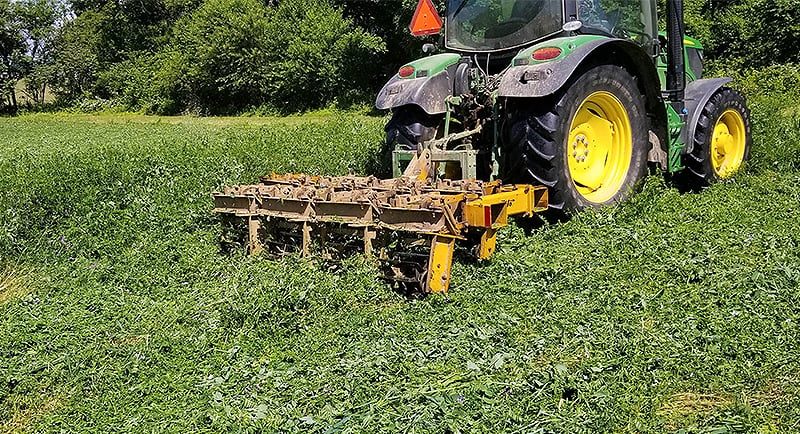Recent Penn State research is giving organic growers tips on timely termination of hairy vetch and cereal rye through roller crimping based on the reproductive state of the cover crops. In addition, the studies look at the consequences of incomplete termination of the two covers in later rotations. John Wallace, assistant professor of weed science, says there’s growing interest in using cover crops to reduce tillage in organic grain rotations by using rolled cover crop residues as a mulch to suppress weeds during the summer cash crop growing season.Hairy vetch
“A mix of hairy vetch and a winter grain is often used before corn and cereal rye is predominantly used before soybeans,” he explains. “For this strategy to work properly, timely termination is necessary to prevent covers from producing viable seed and possibly becoming a volunteer later in the rotation.”
Wallace says hairy vetch is generally sown alone or with a grass, such as triticale or cereal rye, and it is rolled before planting corn.
“Triticale can be a better companion crop for a rolled hairy vetch than cereal rye because triticale matures at the same time as hairy vetch,” he explains. “Cereal rye will mature earlier than hairy vetch, making optimum rolling timing more complicated.”Hairy vetch is a legume capable of producing 3 tons of dry matter biomass and providing 180 pounds per acre of nitrogen to the following cash crop, he says.“We recommend roller-crimping when hairy vetch is at full bloom to early pod set,” he says. “Hairy vetch biomass does not increase much after full bloom and as it starts to fill pods, so there may be a slight decrease in biomass as lower leaves begin to senesce.“However, hairy vetch biomass is still sufficient to form the mulch needed to suppress weeds in the early stages of corn development and before the hairy vetch biomass decomposes.”Penn State research conducted over a 3-year period indicates waiting until full bloom is critical to control hairy vetch and limit seed production — and minimize volunteer problems in other phases of the rotation. Hairy vetch biomass does not increase much after 80% bloom, but the percent of hairy vetch controlled by the roller crimper increases from 80% to 98% as rolling is delayed from 40% bloom to full bloom.Cereal rye
When growing cereal rye to roll and use as a mulch in soybean, later termination results in greater biomass, Wallace says.“Also, late termination of cereal rye can improve control of the cover crop, although control of the standing cereal rye does not eliminate the potential for regrowth or seed production.“If cereal rye is rolled too early (before 50% anthesis), it can produce new tillers that flower and produce seeds. If it is rolled too late (after the medium milk stage), kernels will continue to develop on dying plants and mature on the soil surface. Termination of cereal rye with a roller-crimper should target the period between 50% anthesis and early milk stages.”Wallace says to improve the control over the cereal rye cover crop, Penn State recommends rolling the rye twice, once approximately 1 week before soybean planting and again on the day of soybean planting. Unlike in corn, rolling should not occur after soybean planting to avoid injury to the emerging soybean plants.“We’ve found the weight of the tractor and planter can complement the rolling by further crimping the cereal rye,” he says.
Related Content:
[Video] Roller-Crimping Rye with Scott Shriver
How to Get Effective Cover Crop Termination with Roller-Crimping
[Podcast] The Latest on Cover Crop Research and No-Till Organic Systems with Dr. Erin Silva




